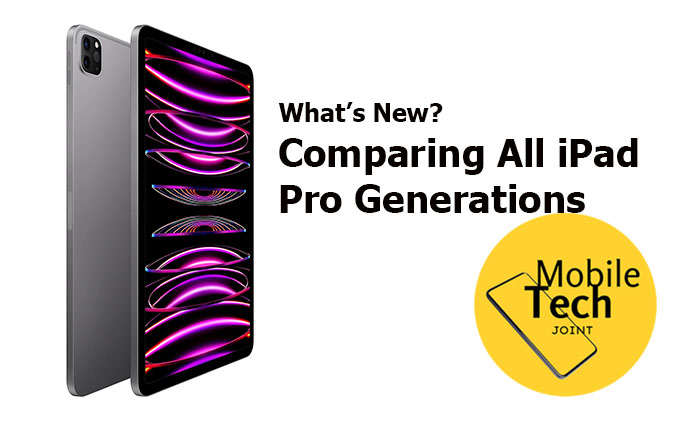The iPad Pro launched in 2015 is Apple’s flagship tablet, designed to bridge the gap between tablets and laptops. Known for its powerful performance, advanced display technology, and versatility, the iPad Pro has become a favorite among creative professionals, students, and business users alike. It stands out not just as a tablet, but as a tool that can potentially replace traditional laptops for many tasks. When Comparing All iPad Pro Generations, the evolution of this model showcases Apple’s commitment to innovation and meeting the diverse needs of its users.

The Concept of Generations and Why They Matter for Consumers
The iPad Pro has seen multiple iterations, each bringing new features and advancements. Understanding these generations is crucial for consumers because each one offers different specifications, capabilities, and price points. Whether you’re a first-time buyer or looking to upgrade, knowing the differences between generations can help you make an informed decision that meets your specific needs.
The First Generation iPad Pro
The first-generation iPad Pro was unveiled in September 2015, with a 12.9-inch display (an unprecedented size for an iPad). It introduced the A9X chip, which brought laptop-level performance to the tablet, and was the first iPad to support the Apple Pencil, making it a hit among digital artists and professionals.
Key features included a high-resolution Retina display, advanced multitasking capabilities, and a four-speaker audio system. It also introduced the Smart Connector, allowing users to attach accessories like the Smart Keyboard without the need for Bluetooth or additional ports.
The Second Generation iPad Pro
Released in June 2017, the second-generation iPad Pro brought significant improvements over its predecessor. It came in two sizes: the original 12.9-inch and a new 10.5-inch model, replacing the 9.7-inch version.
The most notable upgrades included the A10X Fusion chip, offering faster processing power and improved graphics performance. The ProMotion technology was introduced, which doubled the display refresh rate to 120Hz, making for smoother scrolling and more responsive touch inputs. This generation also saw enhancements in the camera system, adopting features from the iPhone 7.
The Third Generation iPad Pro
The third generation, launched in October 2018, marked a significant redesign for the iPad Pro. Apple removed the Home button, drastically reducing the bezels and introducing Face ID for the first time on an iPad. This generation was available in 11-inch and 12.9-inch sizes.
Equipped with the A12X Bionic chip, the third-generation iPad Pro delivered desktop-class performance, capable of handling demanding tasks like video editing and 3D rendering. It also introduced USB-C, replacing the Lightning port, which expanded connectivity options and made it easier to connect external devices like cameras and monitors.
The Fourth Generation iPad Pro
Released in March 2020, the fourth-generation iPad Pro continued to build on its predecessors’ strengths while introducing notable new features. The most significant upgrade was the inclusion of a dual-camera system with a 12MP wide camera and a 10MP ultra-wide camera, along with a LiDAR scanner for enhanced augmented reality (AR) experiences.
This generation also saw the introduction of the Magic Keyboard, which featured a floating design, backlit keys, and a trackpad, bringing the iPad Pro closer to a laptop experience. Additionally, the Apple Pencil’s latency was further reduced, making it even more responsive for drawing and writing.
The Fifth Generation iPad Pro
The fifth-generation iPad Pro, released in April 2021, was a game-changer, as it was the first iPad to be powered by the M1 chip—the same chip found in Apple’s latest MacBooks. This gave the iPad Pro an unprecedented performance boost, making it one of the most powerful tablets on the market.
The 12.9-inch model introduced a mini-LED display, branded as the Liquid Retina XDR, offering significantly improved brightness, contrast, and color accuracy. This generation also added support for Thunderbolt 3 and 5G connectivity, ensuring faster data transfer and internet speeds.
Comparison of Generations
To help consumers choose the right iPad Pro, it’s essential to compare the key features of each generation. This section should include a table or chart highlighting differences in screen size, processor, storage options, camera capabilities, and other significant features. Over the years, the iPad Pro has evolved from a powerful tablet to a device that can truly rival traditional laptops.
Comparison Table of iPad Pro Generations
| Generation | Release Date | Display | Processor | Key Features |
|---|---|---|---|---|
| 1st Gen | November 2015 | 12.9-inch Retina | A9X | Apple Pencil support, large display |
| 2nd Gen | June 2017 | 10.5-inch & 12.9-inch ProMotion | A10X Fusion | 120Hz refresh rate, improved performance |
| 3rd Gen | November 2018 | 11-inch & 12.9-inch Liquid Retina | A12X Bionic | Edge-to-edge display, Face ID, USB-C |
| 4th Gen | March 2020 | 11-inch & 12.9-inch Liquid Retina | A12Z Bionic | Advanced camera system, LiDAR scanner, Magic Keyboard |
| 5th Gen | April 2021 | 11-inch Liquid Retina & 12.9-inch XDR | M1 | M1 chip, Liquid Retina XDR, 5G connectivity |
Each generation has introduced enhancements that make it more capable, versatile, and user-friendly, catering to a wide range of professional and personal use.
Best Generation for Budget, Usage, and Desired Features
When choosing an iPad Pro, consumers should consider what they intend to use it for. If you need top-tier performance for tasks like video editing, the fifth generation with the M1 chip is the best choice. For more casual use, an earlier generation might offer all the features you need at a lower price.
Budget is a significant factor, as newer generations tend to be more expensive. Users should also think about their specific needs—whether they prioritize display quality, processing power, or portability—and choose the generation that aligns with those priorities.
Future of the iPad Pro
Looking ahead, the future of the iPad Pro likely involves further integration with macOS, more advanced display technologies like OLED or microLED, and even more powerful chips. Rumors suggest that future models might feature under-display Face ID or Touch ID, as well as improvements in battery life and portability.
Emerging trends like foldable displays, improved AR capabilities, and AI-driven features could play a significant role in shaping the next generation of iPad Pros. As Apple continues to push the boundaries of what a tablet can do, the iPad Pro will likely become even more central to the ecosystem of creative and professional tools.
Conclusion
The iPad Pro has evolved dramatically since its introduction, with each iPad Pro generation bringing new features and capabilities that have solidified its place as a powerful, versatile tool. Whether you’re looking for a portable studio, a laptop replacement, or a device for everyday tasks, the iPad Pro offers something for everyone.
Understanding the differences between iPad Pro generations is crucial for making an informed purchase. By knowing what each version offers, consumers can select the model that best fits their needs, ensuring they get the most value out of their investment.
Also Check:
- How to Take Screenshot on iPad Pro
- iPad Pro not Charging when plugged in, how to fix
- ISOtunes Sport ADVANCE BT Shooting Earbuds: Tactical Bluetooth Hearing Protection for $139.99
- Status Between 3ANC True Wireless Earbuds: Premium Noise Cancellation and Audio Quality for $179.00
- Shure MoveMic Two – Pro Direct to Phone Wireless Lavalier Microphones: Your Go To…
